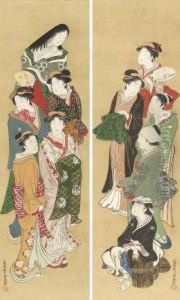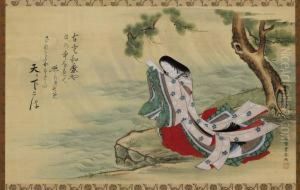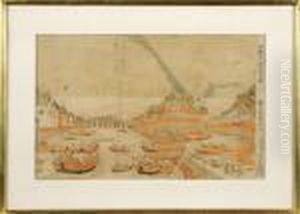Utagawa Toyoharu Paintings
Utagawa Toyoharu was a Japanese artist known for his contributions to the Ukiyo-e genre of woodblock prints and paintings. Born in 1735, Toyoharu was active during the Edo period, a time when the Ukiyo-e art form was gaining considerable popularity in Japan. He is particularly famous for founding the Utagawa school, which became one of the most significant and prolific schools of Japanese woodblock printing.
Toyoharu's early life is not well-documented, but it is believed that he originated from Toyooka in the Harima Province (present-day Hyōgo Prefecture). He later moved to Edo (now Tokyo), where he began his artistic career. Initially, Toyoharu started by painting in the Chinese-style (kara-e), which was quite common among Japanese artists of the time. However, he also studied Japanese painting styles (yamato-e) and the Western perspective drawing (uki-e), which influenced his later works.
One of Toyoharu's significant contributions to Ukiyo-e was the introduction and popularization of perspective in Japanese prints, a technique he may have learned through Dutch copper engravings that found their way to Japan despite the nation's policy of isolation. His uki-e works depicted famous places in Japan and scenes from Kabuki theatre, often using one-point perspective to create a sense of depth, which was novel for Japanese viewers at the time.
Toyoharu’s work is characterized by a delicate and refined use of line and color. While he created many traditional Ukiyo-e subjects such as bijinga (pictures of beautiful women) and yakusha-e (pictures of actors), his landscapes and perspective prints had a lasting impact on the development of the genre. His ability to blend Eastern and Western techniques and subjects helped set the stage for future Ukiyo-e artists, including many of his students.
As the founder of the Utagawa school, Toyoharu trained a number of distinguished artists, such as Utagawa Toyokuni I, who would continue the school's legacy well into the 19th century. The school eventually became the most commercially successful and prolific school in the late Edo period, with Hiroshige and Kunisada among its most famous members.
Utagawa Toyoharu passed away in 1814, leaving behind a rich legacy that influenced not only his direct students but also the broader trajectory of Japanese art. His integration of Western perspective into traditional Japanese subjects helped bridge cultural divides and pushed Ukiyo-e into new realms of artistic expression.


